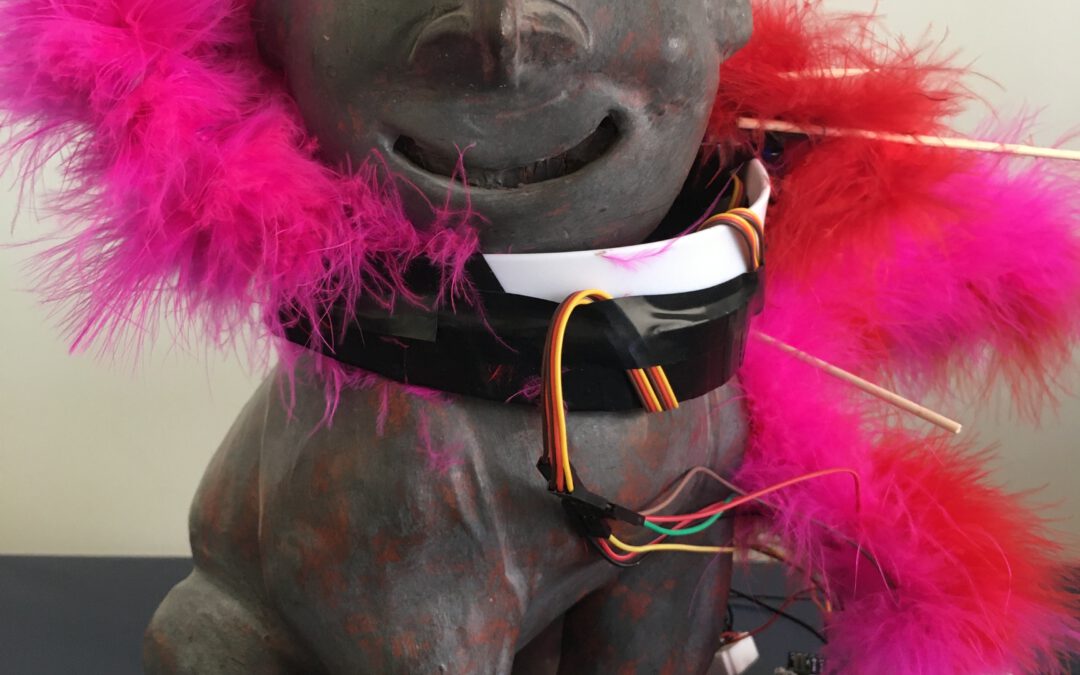Motors, joints, muscles, codes, cables, the body, and an Arduino-based suit. A suggestion to invest time in building and testing the aesthetic and performative quality of combining two types of understanding and experiencing movement and vitality from a choreographic and mechatronic perspective. Programming, crafting, and dancing come together to find out answers to open questions about the shared movement.
Gefördert durch die Beauftragte der Bundesregierung für Kultur und Medien im Programm NEUSTART KULTUR, Hilfsprogramm DIS-TANZEN des Dachverband Tanz Deutschland.
Thank you for the support!
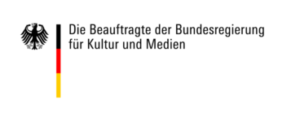
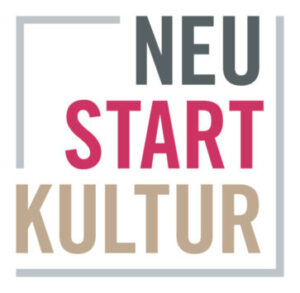
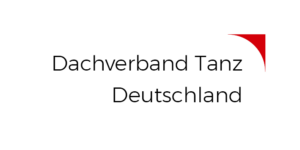
D O C U M E N T A T I O N
From January to June 2023 I had the opportunity to spend time learning about microprocessors, Arduino IDE, motors, kinetic sculpture, and about movement outside the human body. Here are my notes throughout the process, starting with the conclusions…
This work requires an interdisciplinary mindset and praxis. It involves knowledge of physics, mechatronics, coding, design for kinetic sculpting and puppetry, as well as handcraft skills to bring the designs into the physical world. Developing artistic projects of this nature requires a team with each of these areas of expertise. I am passionate about this work and eager to further develop my skills. I aim to articulate concepts and working methods that are suitable for this kind of interdisciplinary team.
A highlight of the research is the surprising variety of movement quality that each motor offers, regardless of the mechanism used to transfer mechanical energy. Even the simplest structures offer a lot of potential for creating movement. It’s not just a question of how something can be moved, but also a question of the quality of the movement. However, this quickly leads to the design question of what is going to be moved.
Usually, my reflections ended up with the question: does this have choreographic potential? Could everything be choreography? Or maybe it is time for me to open up my artistic process to include another artistic perspective.
The paradox of the more-than-human potential more than ever: this philosophical concept could be treated artistically using this medium. However, I do not want to overlook the entire production cycle and isolate the artistic product as if it came out of nothing. The theme could be “more-than-human,” but the resources required to create it are not environmentally friendly, which makes it again human-focused. How can we address this issue?
I support the integration of digital technology in choreography creation. However, I find myself more drawn to the physicality of objects and bodies, and I think that digital models lack this aspect. Through this research, I have come to understand why I prefer learning about microprocessors over learning about choreography with VR or AR, for example. For me, it is crucial to be able to feel the material and interact with a physical body. While I acknowledge the value of digital tools, I am more interested in the tangible experience and haptic feedback of creating something. In other words, I want to physically engage with the process, rather than just observing it through a screen. I look forward to finding new ways to integrate these digital tools into my work, while still prioritizing the physicality of the outcome.
While this research expanded my understanding of movement, it also took me completely out of my body. This was an unexpected deviation during the research, and it left me wondering how to come back to my body. In the few moments in which I felt that I was working through the choreographic lens, it felt more like creating sequences of steps rather than creating an experience with nuances and layers. In my creative process, I prioritize the experience of the body over the technique and virtuosity of a dancer’s skills. While I acknowledge that a structure with microprocessors can become virtuosic, mastering this technology is not my primary interest. Instead, I am curious about how to use this material to create experiences. The part of the research that felt most relevant to this goal was coding.
I went through three stages of learning: starting with the basics of Arduino, exploring movement and mechanisms in general, and then focusing on specific elements of Arduino IDE. My learning curve was slower than expected, which is a clear case of the Dunning-Kruger effect. The tension between the artistic vision and the practical aspects of working with this material was overwhelming. A lot of time was invested in a small effect that is not yet artistically interesting. However, the insights into choreography, dance, and movement are very valuable to me. I will use them in my upcoming production with TachoTinta.
The following questions arise after dedicating six months to learning about Arduino IDE and the possibilities of microcontrollers in choreography:
- What about liveness?
- What about the use of materials and the cycle of energy?
- Is this the type of artistic work the world needs?
- Is my fascination for this type of work and dedicating time to learn completely against the big challenges we are facing globally?
- How does this work actually perpetuate actions that worsen climate change?
- How could this contribute to a more-than-human worldview?
- How could this contribute to challenging discriminatory systems and attitudes?
- How does this offer a space of reunion & empathy?
- How could this highlight a sensual experience of our body in space?
These questions are intertwined and cannot be considered alone.
JANUARY
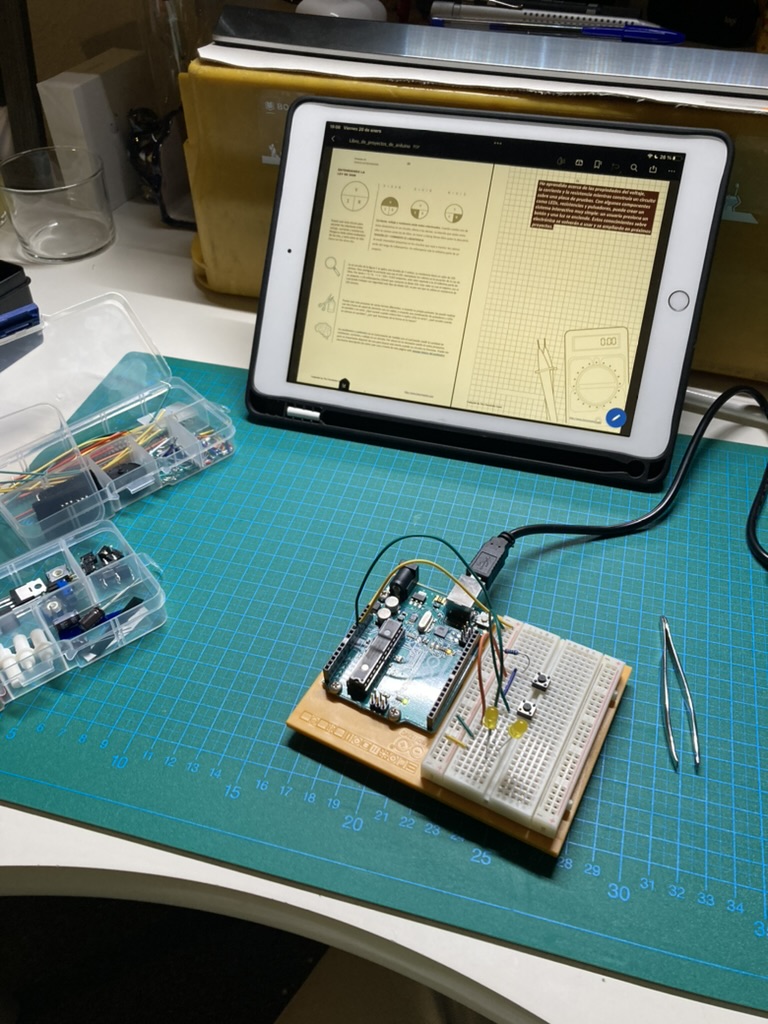
The research focus of the month:
- robots (Boston Dynamics, Stunt robots from Walt Disney, Ameca, Atlas, Leonardo)
- the terms & coding language
- the thinking & communication structure
- how does electricity behave in these circuits, tension, polarity
- about components: sensors (they “listen” the physical world), motors, sketches, microcontrollers (they “talk”)
I started taking handwritten notes but noticed that this research was not going to be a linear one. Although I already use the clipbook to move pages back and forth, this is not going to be viable throughout the whole time. I need another method.
When it comes to creative activities, such as feedback and sketching, the approach is quite different from that of dance. This could be the reason why, when I initially attempted to contact an Arduino teacher, I received a negative response. The teacher was unable to comprehend the connection between microcontrollers and choreography. However, it is essential to note that while these activities may seem disconnected, they have their own unique creative processes that can be equally fulfilling and rewarding.
I find the parallels and analogies between the human body and mechatronic systems exciting. They provide a deeper perspective on the body and movement. For instance, BodyMindCentering techniques help in understanding the mechanics of sitting: loosening the hip joints, using only the necessary energy to support weight, and allowing everything to flow. Knowing how a motor and a microcontroller can perform this process makes my perception of human movement more complex.
However, although it is a technical knowledge similar to that of physiotherapists, it has little to do with the experience and sensation of it, which sets it apart from an artistic process. I wonder how to link the technical aspect of microprocessors with the artistic aspect of choreographing with them. The consequences of sitting, the intention, and the doing per se. A movement is not just a movement; that is what dance is about. Therefore, how can mechatronics find a space in choreography?
When dealing with the concepts of choreography in the digital realm, one might find themselves confronted with peculiar terminology. The use of terms such as “digital choreography” or “binary choreography” may lead to confusion or misunderstandings, as they lack a clear definition or context. However, by breaking down the process of choreography into its fundamental components of 0’s and 1’s, one can begin to understand the intricate relationship between movement and technology. This digital medium has unique challenges, how do I relate to them as a choreographer and dancer? The seemingly simple concepts of 0’s and 1’s can lead to a world of endless artistic possibilities.
FEBRUARY
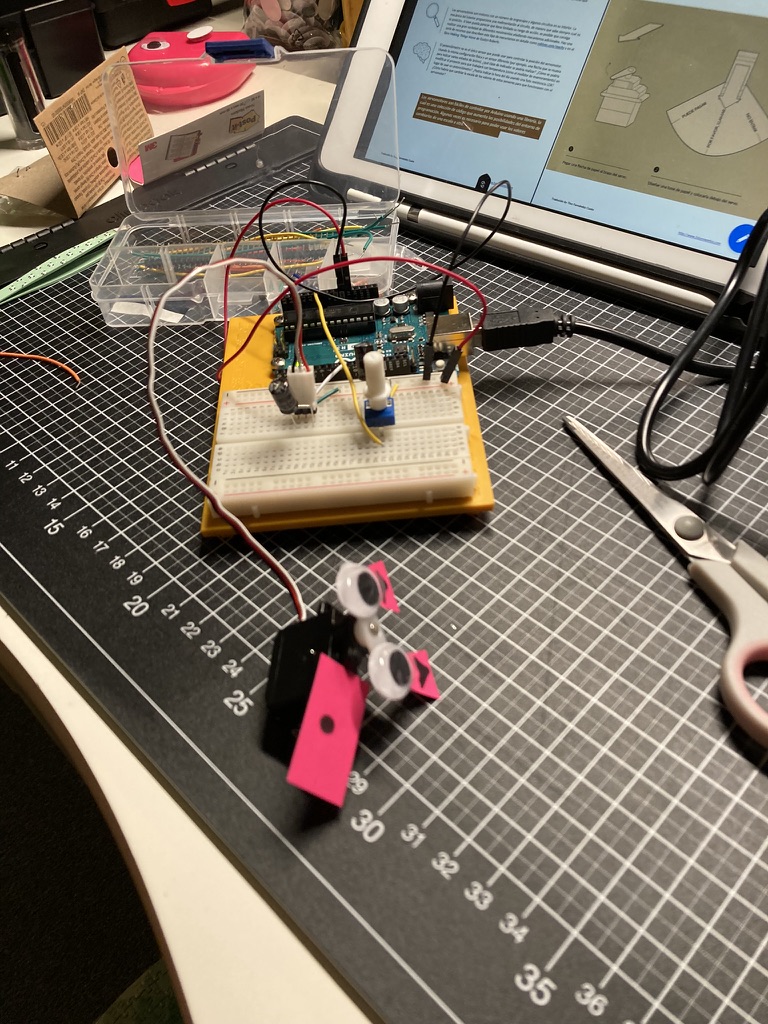 The research focus of the month:
The research focus of the month:
- energy and transforming processes
- solar punk movement
- Arduino basics
Notes about energy:
Energy transformation is a fascinating process that involves the conversion of one form of energy into another. The transfer of energy can be from one object to another, or from one system to another. It is a continuous process, and there are several types of energy transformations that can occur simultaneously. Energy can be transformed into heat, light, sound, and mechanical energy, among others.
The flow of energy is an interesting concept that is closely related to the paths of least resistance. Energy flows through these paths, which are the easiest ways for energy to travel. Energy flows through these paths because they offer the least resistance, allowing energy to move easily from one place to another.
Energy transformation and flow are both interesting processes present everywhere: from the generation of electricity to the functioning of our bodies, energy transformation and flow are present in almost everything we do. Is there a choreographic potential in this process?
TYPES OF ENERGY | Physics Animation
Types of energies that are interesting for me:
kinetic energy: energy of objects in motion (the form of energy that an object possesses due to its motion) energy
light energy: a type of kinetic energy, related to electromagnetic radiation of a wavelength
electrical energy: a type of kinetic energy, caused by the movement of electrical charges called electrons, like a thunderstorm, electric eels
potential energy: energy that is stored in an object that could move
gravitational energy: the potential energy stored by an object because of its higher position compared to a lower position, that will be released when the object falls.
(fun fact→ Chemical energy is a form of potential energy because it can be stored and then released through chemical reactions, it is the most used type of energy in the world, like with the food that gives us warmth and allows us to move)
mechanical energy: the type of energy you use when working, energy acquired by objects upon which work is done. An object acquires mechanical energy due to its motion or position, it could be either kinetic or potential.
How much time could a motor run? How much time could a body run? How much effort could a motor apply? How much effort could a body apply? What about sensitivity? How to make a circuit sensible? How do the robots from Boston Dynamics do this?
I started making my notes in Notion, so I can consult them later. A good choice!
I took a detour to read and listen to Olafur Elliason, he has a particular way to talk about energy transformation, space, time, and the body. And discovered SolarPunk movement.
Meetings with Al Buchwald, a visual artist who specializes in kinetic structures.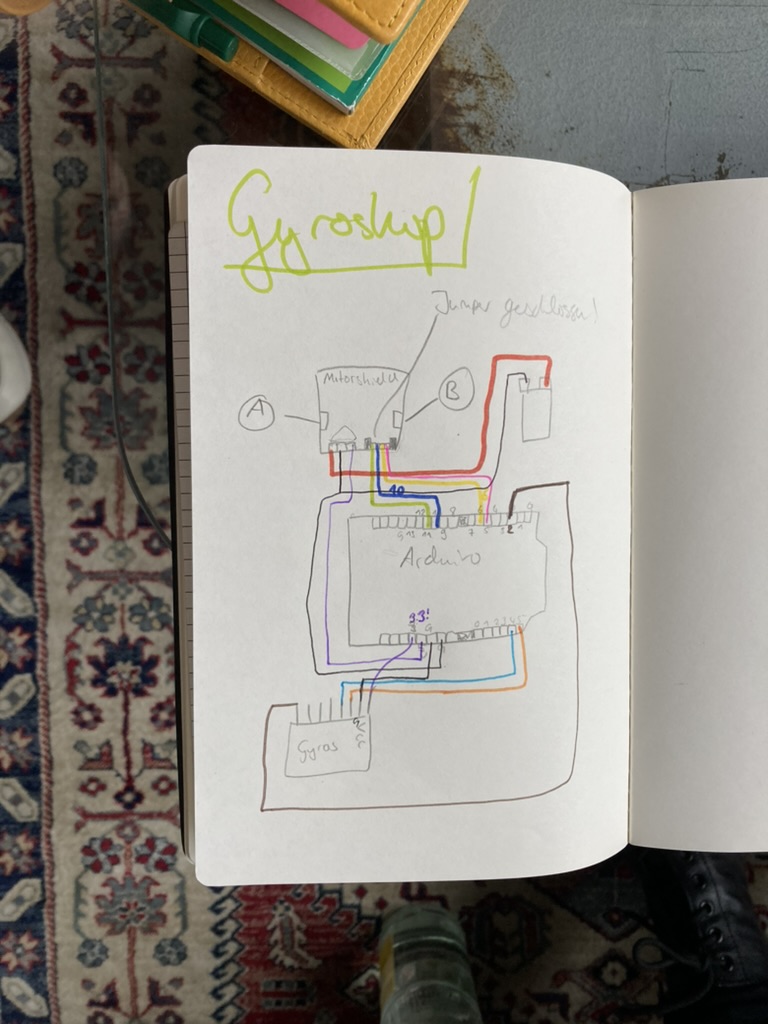
- it is more about the mechanisms, the design, the microcontrollers is just the beginning
- talked about different components that are interesting for movement and interaction, like the different type of motors (DC motors, servos, stepper) & sensors (ultrasonic, gyroscope, buttons)
- she showed me the Maker Space in Bochum, but the Arduino station was not open yet.
Important note regarding the artistic use of microcontrollers, while working on a project in the Arduino Handbook:
!! Simply turning on an LED does not communicate anything, but rather merely indicates that the system and circuit are powered. We have to frame the functionality of the LED in a meaningful way. This is where our creativity comes into play and we can explore the possibilities of how to communicate our ideas through the use of microcontrollers. !!
Learning about energy from a physical perspective was mind-blowing. This triggered my imagination and left me wondering how an artistic idea can be nurtured by this knowledge.
MARCH
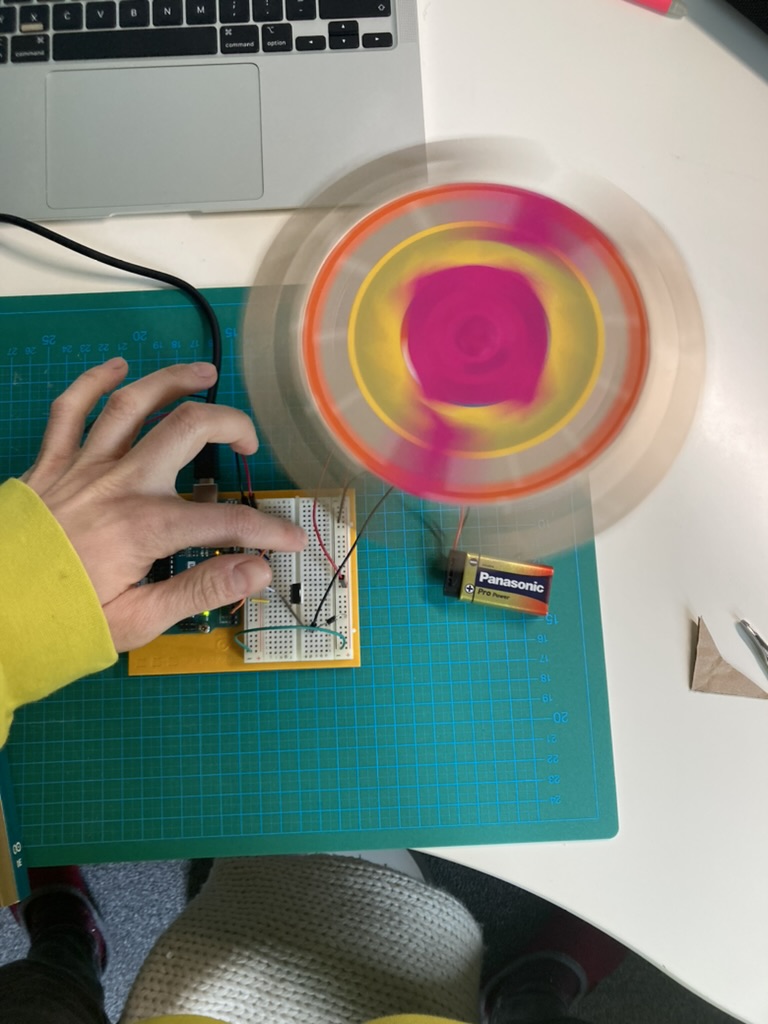 The research focus of the month:
The research focus of the month:
- Book “Make things move” by Dustyn Roberts
- Motors, mechanisms & machines
- Kinetic Sculpture
- Use of motors in Arduino IDE: servomotors, DC motors, steppers
I found the book “Make Things Move” by Dustyn Roberts and attempted some of the mechanisms, but I struggled with it. The book covers design and basic concepts that can be applied to kinetic sculpting.
After completing the first Arduino Project Handbook and learning the basic principles of the projects, I decided to further by exploring another handbook. This time, I delved into more complex examples and challenges, which required me to apply the knowledge I gained from the previous handbook. I found myself spending several hours immersed in the projects, tinkering with the codes and experimenting with different components to achieve the desired results, but with little to no success, failure and dead ends were the order of the day. I spent time learning how to recognize basic errors, and how to debug and troubleshoot connection issues.
So after playing around with the servo motor for a bit, I finally got it to move just the way I wanted it to, instead of just following the boring old handbook instructions. The sense of accomplishment I felt was exhilarating, though my understanding of how the mechanism works is still very superficial. The mechanism itself is straightforward and uncomplicated, and it did not take me too much time to exhaust all of the different ways in which I could manipulate it. How to surpass this short moment of fascination?
I attempted to create a movement using a small figure that I had at home. I focused solely on the mechanics and not the design, as I found myself becoming too distracted by its appearance. This led me to ponder the relationship between the effect and affect in terms of understanding the universe exclusively through observation of its effects, while the actual mechanisms often remain hidden from us.
I discover the fascinating world of kinetic sculptures and the artists who create them. Like the works of Casey Curran, whose intricate designs incorporate organic and mechanical elements to create mesmerizing pieces. Or the world of Rebecca Horn, whose sculptures use movement and sound to create immersive experiences for viewers. Experience the mechanical wonders of Jean Tinguely, whose kinetic sculptures are a playful exploration of movement and technology. And finally, explore the innovative works of Postorganic Bauplan, a Berlin-based collective whose unique sculptures merge technology, biology, and choreography. And I discovered the YouTube channel from Johann Perez E, my guru.
APRIL
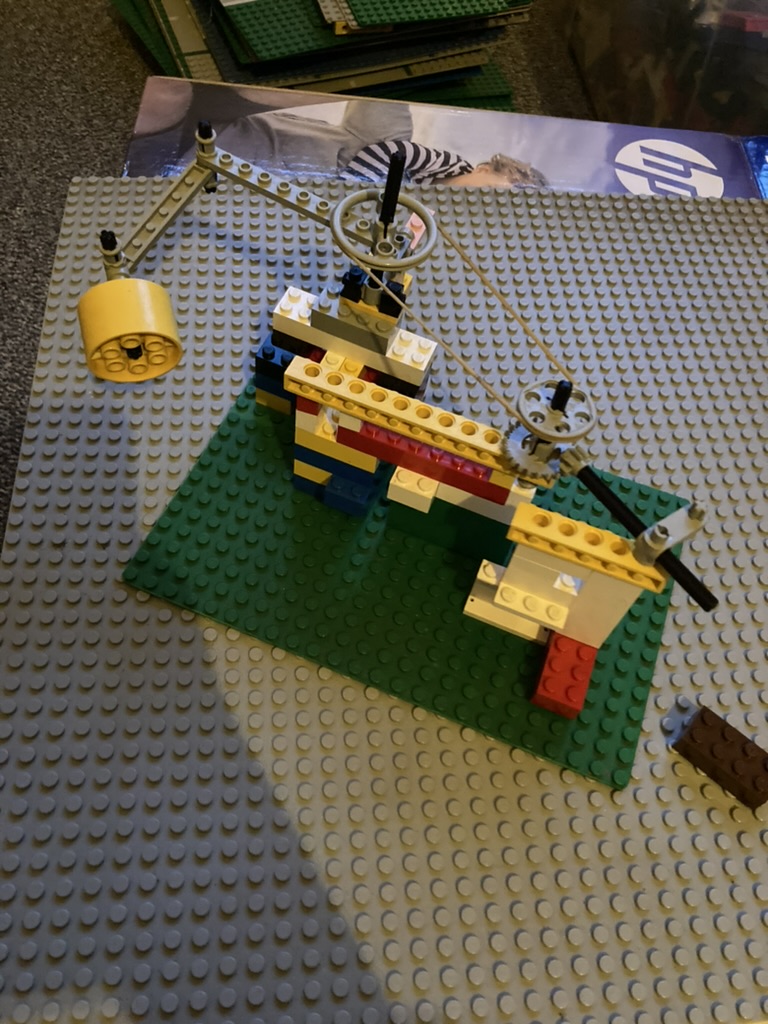
The research focus of the month:
- mechanical structures
- observing movement in living things and human-made things
- two motors simultaneously
- ecological sustainability of this process
- Book “Cats’ Paws and Catapults: Mechanical Worlds of Nature and People” by Steven Vogel and Kathryn K. Davis
I stumbled upon the Youtube Channel “Barb Make Things” and was immediately intrigued by the structures she created using chains and articulations. This led me down a rabbit hole of discovery into the world of DIY wearable electronics, which have proven to be more suitable for mobility. What particularly caught my attention was the fact that these wearable electronics use a different kind of microprocessor produced by Adafruit and not those produced by Arduino, which I had previously been working with. Through further research, I have come to appreciate the versatility and potential of these wearable electronics, but if I was going to go down this path, I would have to purchase additional material.
The books I have been reading have led me to contemplate the intricacies of movement mechanisms beyond just microcontrollers. In order to broaden my perspective, I have spent a considerable amount of time observing various kinds of movements, including those found in living beings and human-made objects. Through this process, I have come to appreciate different approaches to movement, such as organic movement, mechanic movement, and mechatronic movement. As a result, I am now exploring the question of what type of movement I am most interested in and how I can apply it to my projects in innovative ways to create more dynamic and engaging experiences for the audience.
In addition to trying out mechanisms from the book “Make things move” that do not require electricity or coding, I have also explored other avenues of tinkering. While these alternatives may not provide the same level of complexity as motors and codes, they do offer a unique perspective on the mechanics of movement. For example, I have experimented with building simple machines using pulleys and levers, allowing me to gain a deeper understanding of the basic principles that govern motion.
However, while I appreciate the simplicity of these mechanisms, I must admit that I still find myself drawn to the mystery and unpredictability of motors and codes. There is something fascinating about the way that these complex systems can come together to create something entirely unexpected. It is this sense of wonder and discovery that brings me back to continue exploring the possibilities of the Arduino mechanisms, so I do not get lost.
This research on micro components and Arduinos has expanded to understand how things move on a larger scale. This requires a different set of skills than simply being able to move your body, as it involves the ability to build things that can move. Where does the choreographic potential lie in this? To choreograph something, it is not necessary to understand how it moves; the focus is different. However, the question of perception is crucial, rather than a technical one. Perhaps this research is, in fact, dance research aimed at understanding how something dances. Alternatively, the next step could be to understand how to transform the movement of something into dance – the process of choreography – by giving it a frame or a score.
Note about the workspace: Changing workspaces is not working out! Clearing everything up and starting again takes time. This is similar to my working process with the company TachoTinta. It is better to have a fixed workspace for three weeks than to be constantly changing, as I need to prepare the space before I can work in it. I need a workshop where I can leave the project I am working on, like the one in Makerspace. Unfortunately, it is not possible to have such a workspace in my home, so I have to keep setting up and tearing it down every day.
More firsts: I attempted to connect multiple motors simultaneously, but it was not always successful due to the need for a stable structure and a significant amount of energy required at once. However, I was able to sustainably add one joint to the body on a small scale. While it is time to try with more joints, having different working spaces is not suitable for this type of work. Another first was managing to get a DC motor to work. This motor is interesting because it can turn 360° and allows for control of both speed and direction.
When considering the stability of the structure, it is important to ensure that all components, including the breadboard, cables, and connections, are well-adhered to each other to support the movement of the motor. This is crucial to ensure that the structure does not collapse or fail during operation. Interestingly, there are similarities between stability and mobility in the body. Just as a stable structure is necessary for the proper functioning of a motor, stability, and balance are important for human movement. Maintaining stability and balance allows us to move and perform complex movements, such as running and jumping, with ease. In contrast, a lack of stability can lead to falls and injuries. The more I get to learn about mechanisms, the more I am amazed by the movement in living things.
Questions about the sustainability of this kind of work.
This type of technology requires a source of energy, usually batteries, and a lot of micro components. I once visited the home of a fellow artist who works with this material and found their house full of electronic components. One might argue that dance, for example, does not produce garbage, so why focus on this? While most of the parts are reusable and need only be purchased once, there are simply too many different components required to create something artistically interesting. I should read about these topics of sustainability in the visual arts.
For sustainability is better to think of non-permanent structures that can be modified, repaired, and dismantled without damage. Re-use and up-cycle are relevant here.
The path connecting to puppetry watched some videos about how to make puppets.
MAY
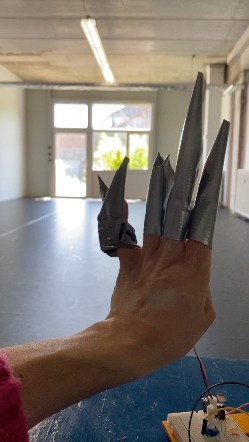 The research focus of the month:
The research focus of the month:
- trouble shooting sketches
- use of Tinkercad to design
- more motors and movement of the body
- brief residency at Quartier am Hafen
Trial and error is the most effective method to make progress. It may take several attempts to achieve the desired outcome, but the process is worthwhile, instead of just googling how other people get to some results. However, I often find that this approach prolongs the time it takes to get to the artistic part of my work. I remain focused on the technicalities of ensuring that my creation functions properly. As I spend most of my time figuring out how to get something to work, my imagination is triggered and I can envision interesting things to try. This sparks my creativity and helps me to explore new ideas. However, sometimes I find that my lack of technical knowledge can become a barrier to my creative process, and I have to search extensively on the internet to figure out how to do something. Moreover, I often realize that I am missing parts needed to make a specific thing work, which can be frustrating. In such cases, I must either purchase more supplies or change my plan.
Troubleshooting is a significant time investment. It takes a long time to find the mistake, particularly in the mechanism, not so much in the coding. While the program can identify syntax mistakes in the code, there are other types of errors that require more attention. This is why I admire Youtuber Johannes Perez, as he does not edit out the error-solving process in his projects. Instead, he shows how to identify and resolve errors.
The difference between working with movement from dancers and working with circuits is quite significant. While dancers can exhibit a wide range of nuances and subtleties in their movements, a circuit is a binary system that is either on or off – there is no middle ground. Simply put, either the circuit is functioning as intended or it is not. Once it is up and running, the adjustment process begins. However, an interesting question arises: how can one perceive the material as something already, even if it is not fulfilling its intended function? This is where the installation approach comes into play. By treating the circuit not just as an object, but as a part of a larger installation, maybe one can create a more dynamic and engaging experience for the audience, even if the circuit itself is not performing any specific task.
I attempted to attach a joint to the body, but my efforts proved to be unsuccessful. Al Buchwald suggested that a type of orthopedic wearable would be necessary to properly attach the motor so that it could be used. As I continued to experiment, I also tried manipulating other objects such as paper and strings in order to gain a better understanding of how they could be manipulated and potentially incorporated into my work.
Personal reminder! I cannot forget that energy has a direction! I am finally understanding the role of current (power) and signal (the code has to make sense). How is this for the human body?
I attended a workshop with Sonia Franken from “El Cuco Project” to learn about the animation of masks.
I discovered Tinkercad, I love it! It helps to sketch and visualize projects.
I had a brief residency in Quartier am Hafen with the intention to invite dancers to try things with the mechanisms, but the material wasn’t ready. Instead, I spent my time sitting at the table, working on the mechanism and code. Eventually, I relinquished the space to someone else and returned to my desk at home to continue the research.
Thoughts about choreography while building mechanisms:
Choreography involves working with movement, the body, space, and time, but the critical factor is determining the source of the movement. If the movement does not originate from a human body, is it a new discipline? This type of work with Arduino requires an expanded concept of choreography, which I find interesting. It opens up possibilities for exploring the “more-than-human” aspect of the movement.
JUNE
The research focus of the month: Build prototypes
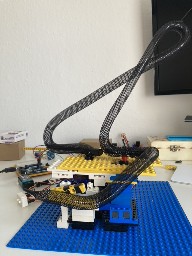
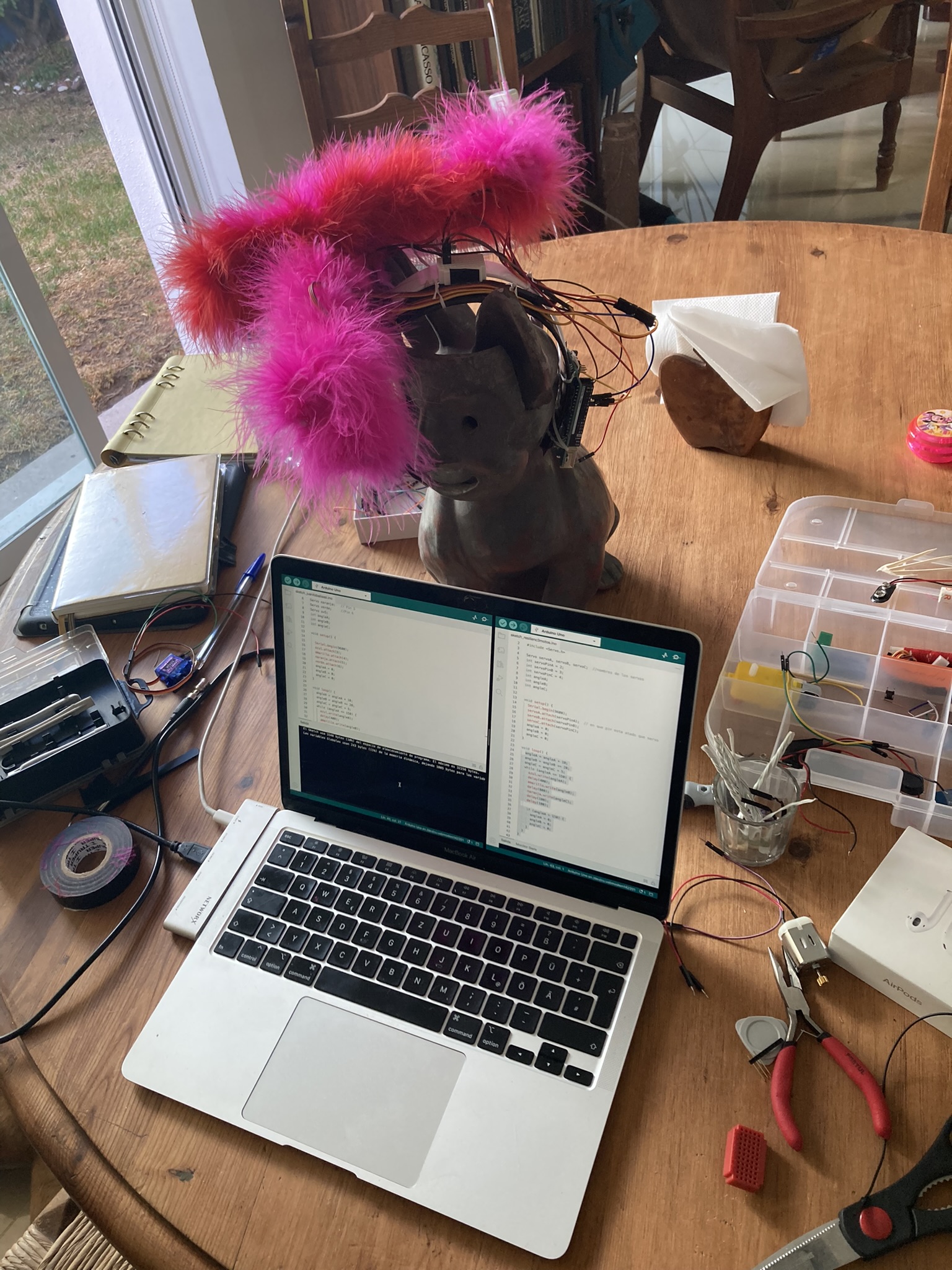
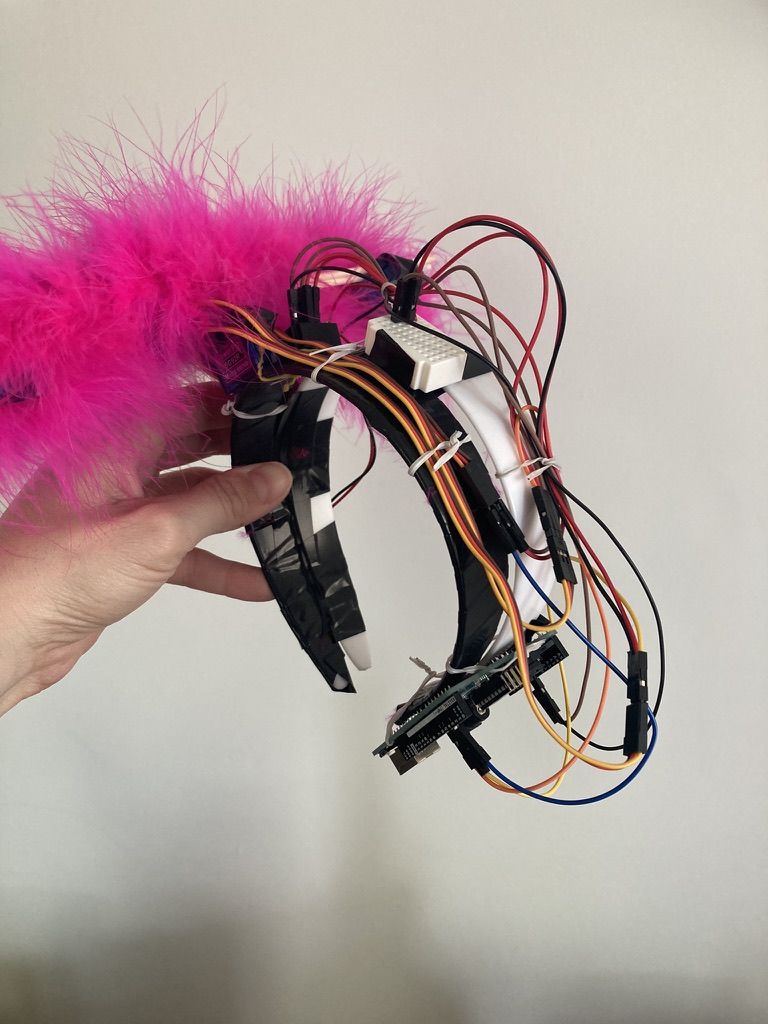
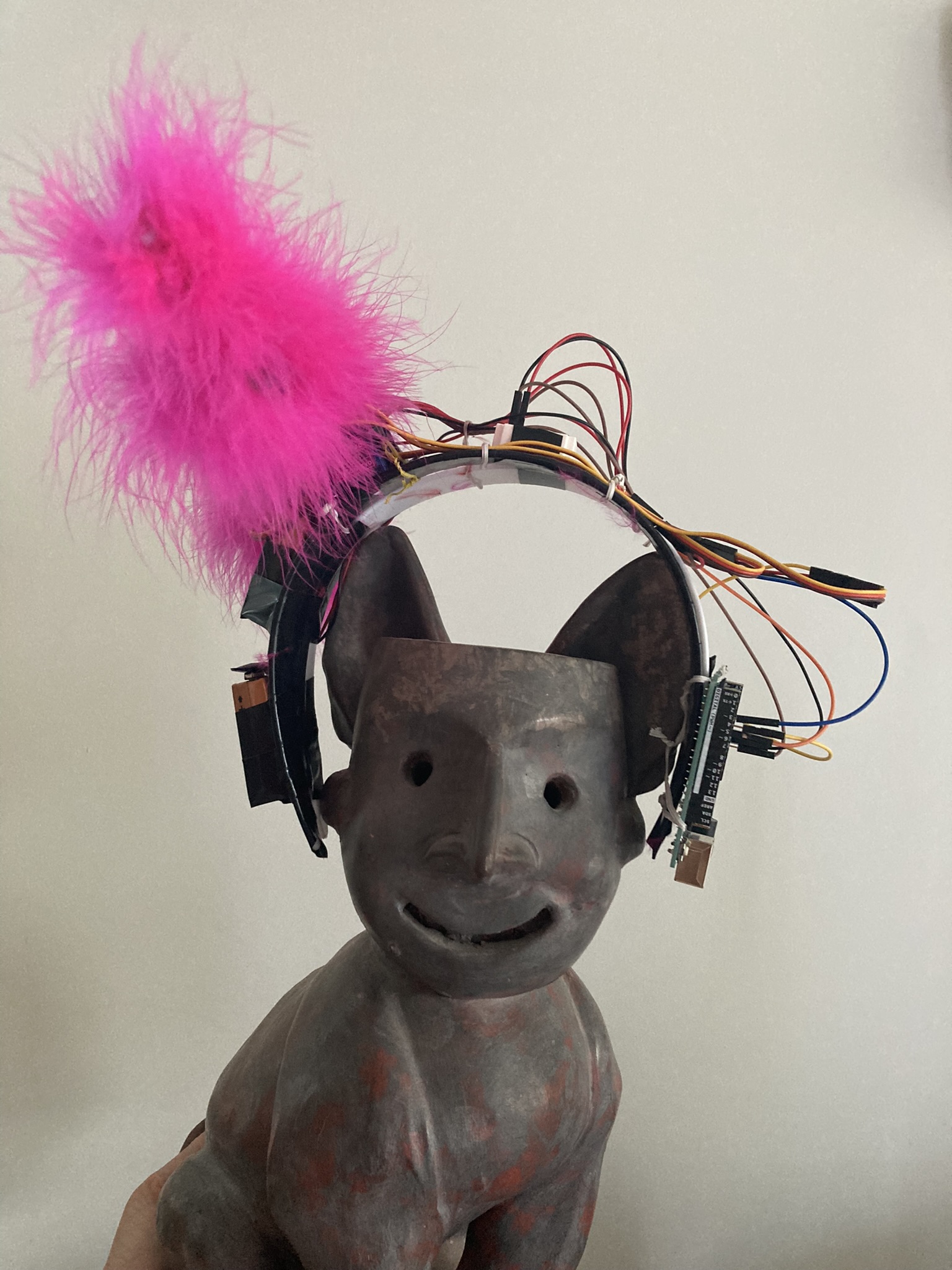
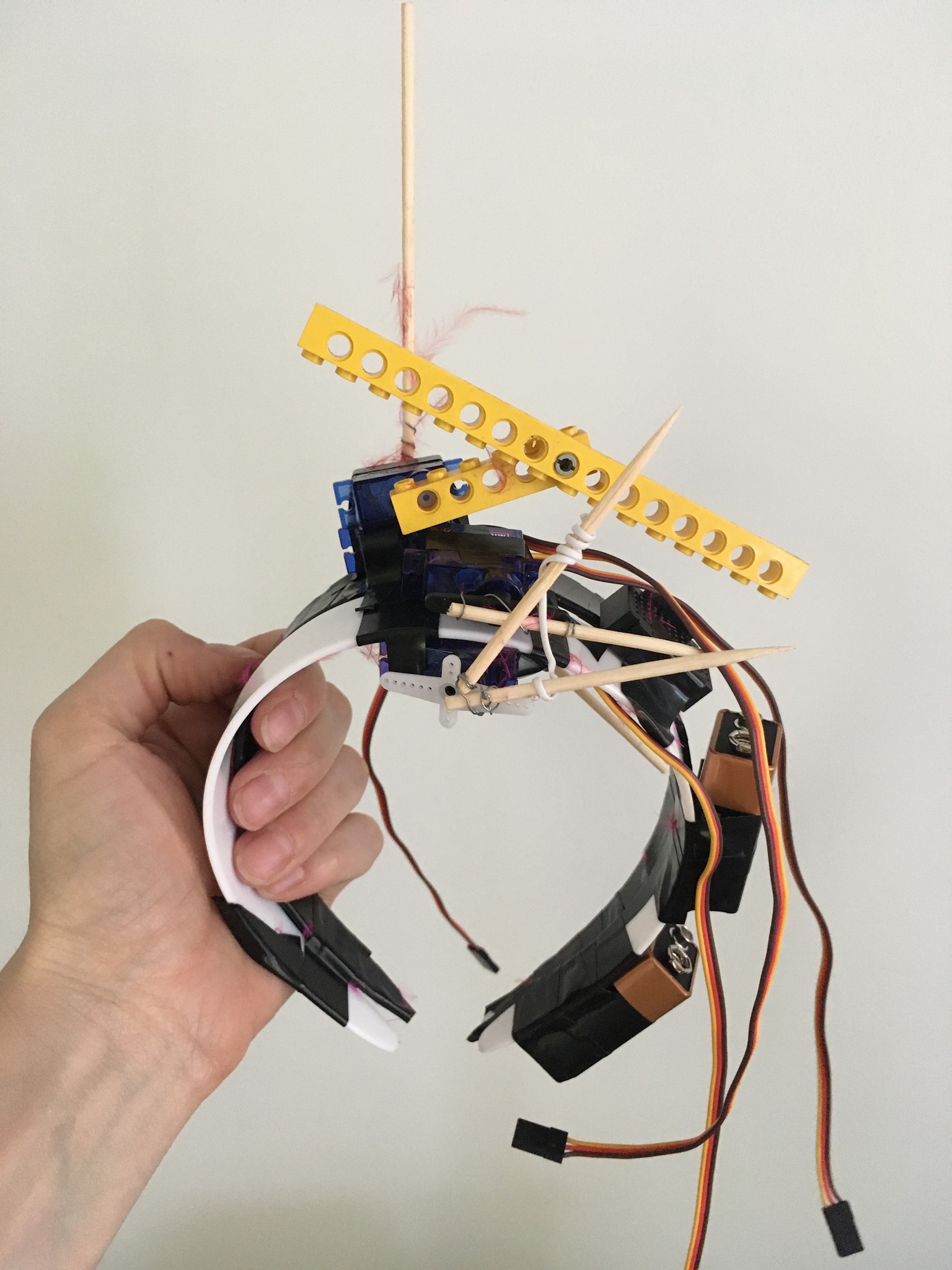
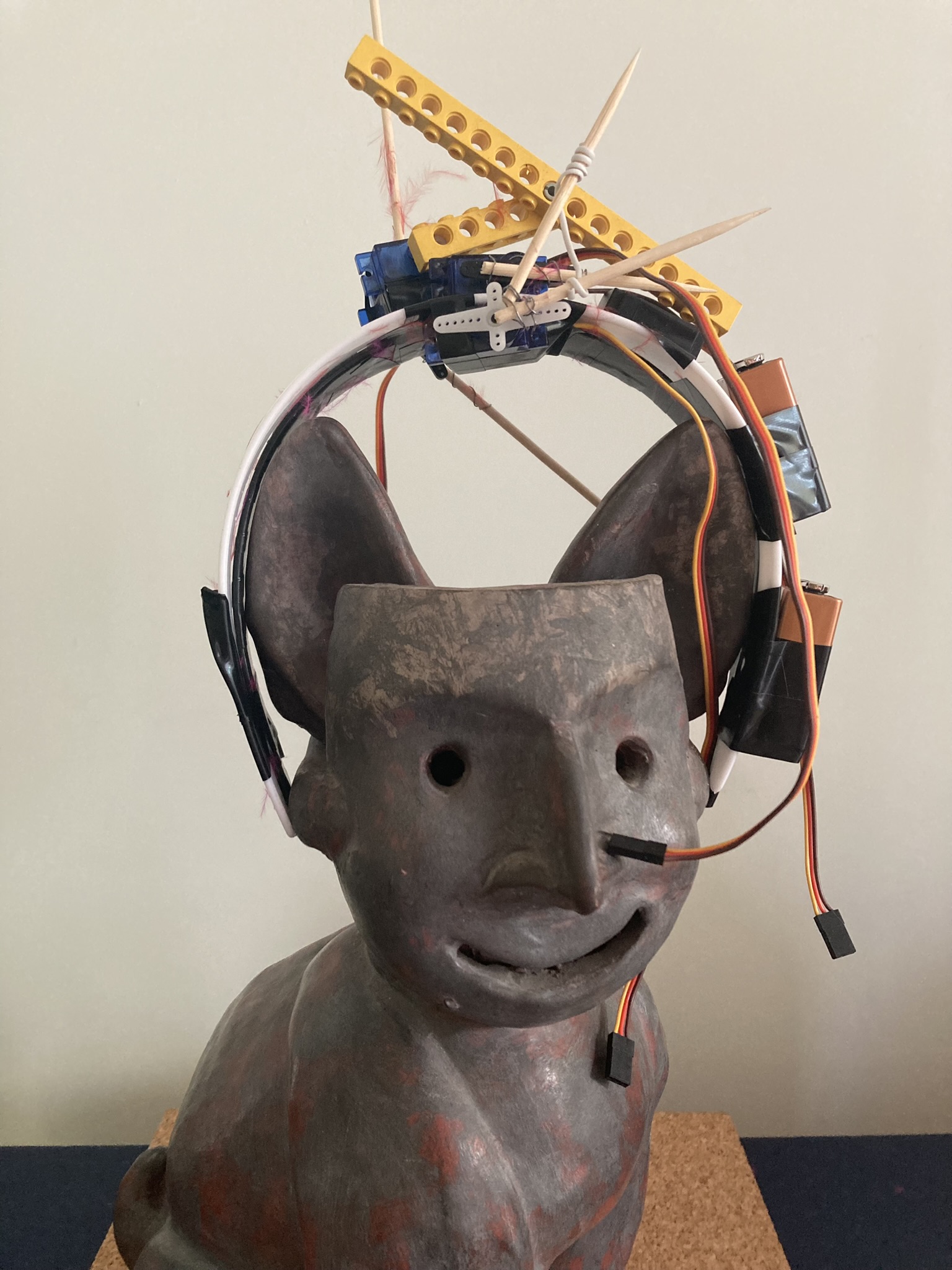
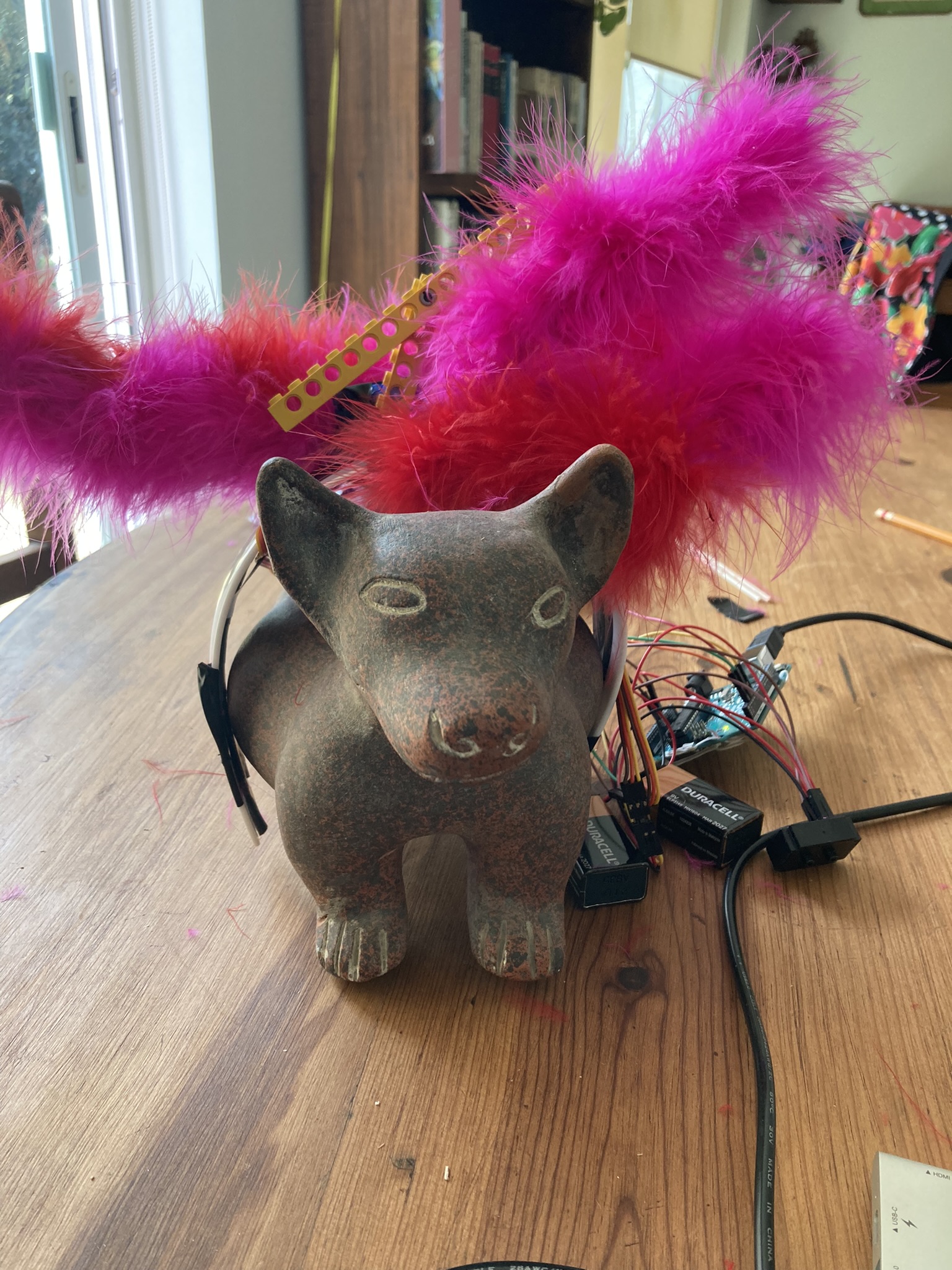
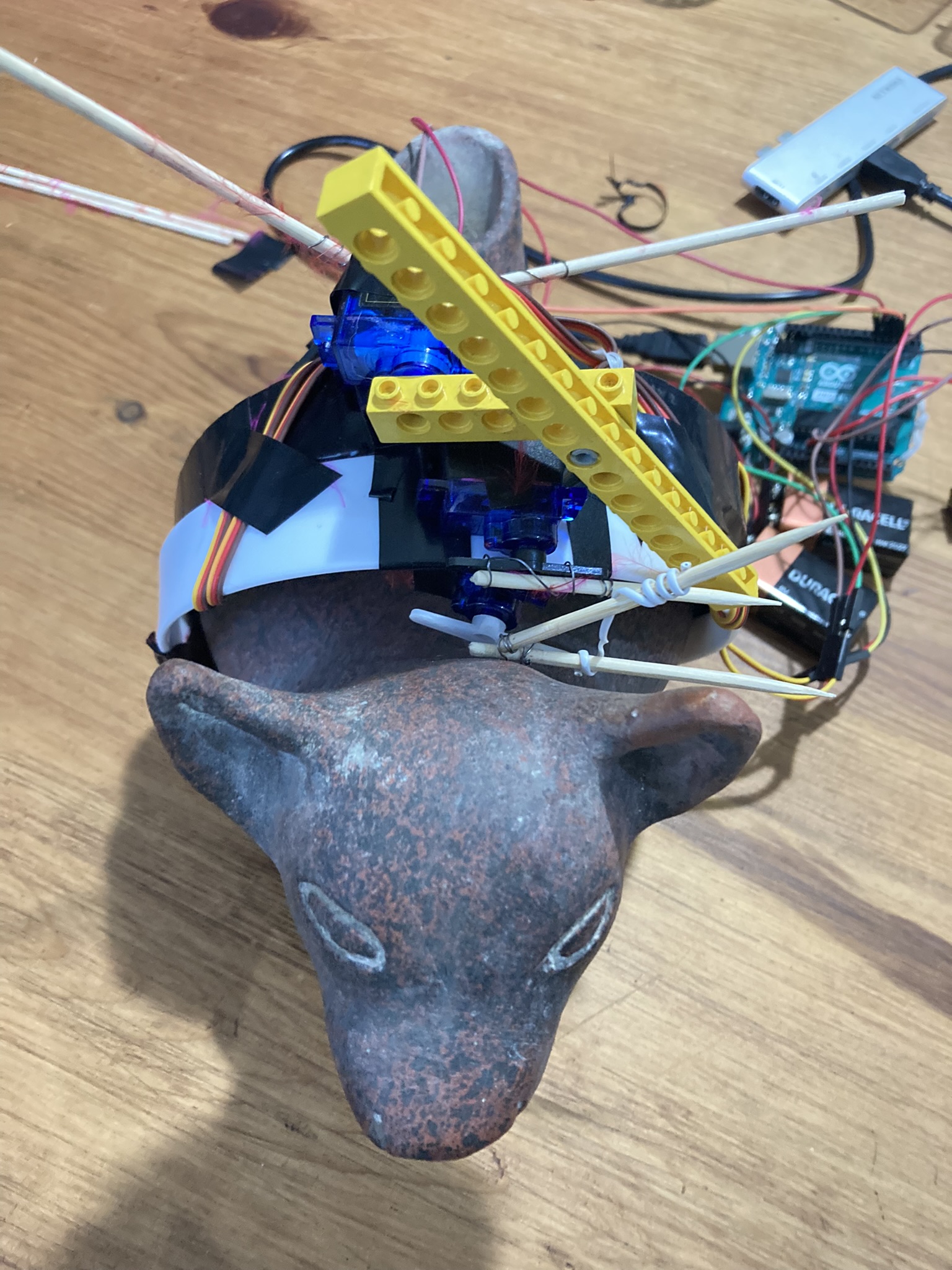
To create a prototype, I followed the score by Dustyn Roberts in “Make Things Move”:
- Decide to make something move
- Find parts and materials to build it
- Design the skeleton (central structure) and fasteners (joints)
I experimented with prototypes made from Legos, sticks, and fake fur. Although I am still dissatisfied with the design aspect, I can see the potential in how the prototypes move. In a last-ditch effort, I added joints to sculptures, which yielded better results, but not quite what I was looking for.
I discovered an artistic approach to this work: exploring the relationship between delays, loops, and rhythm in the code!
When it comes to creating prototypes, be it a physical object or an idea, my imagination is an incredibly powerful tool. However, as powerful as the imagination may be, bringing something from the world of ideas to the physical world can often be a challenge. I need the help of an expert! Using Tinkercad is helpful, while they may not be able to bring a fully formed idea to life, they help me to create a visual representation or sketch of what is in the mind’s eye. The challenge is to have the skills and expertise to turn that idea into a tangible reality.
While the technical process may still be overshadowing the artistic process, it’s important to remember that the two are not mutually exclusive. In fact, by gaining insight into both good and bad practices in coding and Arduino design, you can more effectively integrate both the technical and artistic aspects of your work. It requires focus and motivation to not be discouraged if the technical side of things seems to be taking up more of your time and attention right now. I wonder if it is possible to build a suit that alters your appearance and movement patterns, just as a filter alters your appearance on Snapchat. How would this make you feel?
When a simple prototype works, I experience short moments of fascination, but the resonance is very short. It is a gymic, a movement meme. How to go beyond? My approach until now is to add more motors, but this does not enhance the experience.
Open Source is a peculiar promise – all this knowledge is available online, but you have to delve into what this work means, gather all the necessary parts, and dedicate time. Otherwise, the possibilities are limited and not artistically relevant. Yet, there is something about these kinds of communities that interests me, similar to the fascination with the Solarpunk movement. Being open source or allowing AI to help with the work sometimes feels like outsourcing the learning process, but it has more to do with being autodidactic and going beyond the copy-paste phase.
Motors break, cables tear, batteries run out, and circuits burn. I learned this the bad way. When any of these components fail, it can be frustrating and expensive. At the beginning of this process, I would often immediately look to replace the broken part with a new one. However, over time, my attitude toward these materials has changed. I have come to realize that they are not easily replaceable and that I should treat them with greater care. Instead of simply replacing broken parts with new ones, I now take the time to examine the faulty component and consider if it can be repaired. This has also given me a greater appreciation for the inner workings of the technology that surrounds us. In addition to repairing broken components, I have also started to take a more proactive approach to maintaining the material I purchased for this research. I hope these small steps extend the lifespan of the material and reduce the need for costly replacements.
Digital Library
www.thingiverse.com
www.ponko.com
www.shapeways.com
www.howstuffworks.com
www.instructables.com
www.makethingsmove.com
Motor examples: www.velmex.com/motor-examples.html
Yield strength of things: www.matweb.com
Material catalogue: www.momaster.com
Hardware store US: www.makerbeam.com
Catalogue of polyamides: www.smooth-on.com
Paper animation kits: www.flying-pig.co.uk
Simulator for Ardunios: www.wokwi.com (not so good)
Simulator for Arduinos Circuits and 3D Designs: www.tinkercad.com
